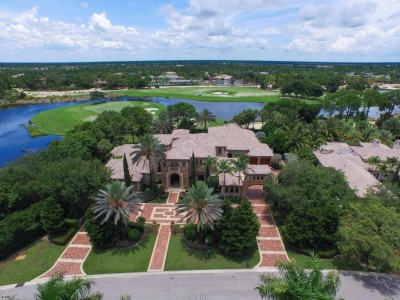Luxury real estate prices hardly budged in the second quarter of 2015, but that understates the vast differences in growth rates across different cities, according to a report by national brokerage Redfin.
By contrast, the rest of the market has grown noticeably, with prices up 4 percent year-over-year, and sales for homes priced above $1 million skyrocketed. An increase in demand due to lowered prices in the second quarter, along with uncertainty in the stock market in the third quarter may lead to slowed growth in both sales and price.
“Though prices were already at a standstill in Q2, sales of $1 million homes surged 14 percent,” said Nela Richardson, chief economist at Redfin, Seattle. “I expect the pace of luxury sales to slow in the next report. The luxury market will probably take a pause as investors, foreign buyers and high-wealth individuals looking for vacation homes sort out whether there will be a prolonged correction in the stock market.”
Coast to coast
Luxury real estate, defined by Redfin as properties in the top 5 percent of value, increased, on average, a mere 0.4 percent. That said, a number of luxury markets have experienced enormous growth in the past year, with Palm Beach Gardens, FL, leading the pack with an enormous 42 percent increase.
San Francisco, home to some of the most expensive luxury and mass-market properties in the United States, has also experienced tremendous growth, with a 24 percent year-over-year increase in the luxury sector.

Beverly Hills Redfin listing
Conversely, Fort Lauderdale, FL, has seen the biggest drop, with prices down nearly 25 percent compared to the same time last year. Stuart and Boca Raton, other Florida markets, are also among the 10 biggest drops, as are Houston and Austin, TX and Los Angeles and neighboring city Irvine, though Huntington Beach and Palm Springs, also in southern California, were among big winners.
The drop in prices has expectedly spurred purchases in almost every market; only Los Angeles saw prices drop without a compensatory increase in sales.
“A slowdown in inventory usually signals an increase in prices; however, even luxury buyers are more cautious about buying at the top of the market,” Ms. Richardson said.
Also of note, of the cities with the largest ratio of luxury real estate prices to prices for properties on the rest of the market, the top nine are located in Florida, with two more rounding out the top 25.
Elsewhere, North Carolina had three such cities: Winston Salem, Charlotte and Greensboro. These cities were ranked number 20, 21 and 25, respectively. Both Texas and California only had two such cities each, represented by Houston and The Woodlands in the former and Los Angeles and San Francisco in the latter.

Palm Beach Gardens, Redfin listing
Technology booms are continuing to have an impact on the market, not just in San Francisco but also in Bellevue, WA, Bend, OR, and Boulder, CO, all of which have a new generation of young, tech-savvy affluents contributing to double-digit growth. The same is true of Reno, NV, which had a 20 percent growth spurt thanks in part to demand from Silicon Valley workers searching for second homes.
Tech boom
The growth of tech companies is already affecting luxury real estate, but the impact might continue to grow over the next several years and into the next decade.
Millennial consumers have radically different preferences compared to their Boomer parents when it comes to purchasing luxury real estate, according to a June 2014 report by Unity Marketing.
The market for high-end real estate has changed drastically over the past decade, and differences between boomers and millennials play a considerable role in influencing current trends. After a brief post-recession rebound in recent years, the luxury real estate market is now settling into steadier pace that will require professionals to cater to millennials’ new preferences (see story).
However, with real estate, it is important to look at long-term trends and avoid making too much of small snapshots.
Case in point: New York real estate prices fell 4.5 percent in the third quarter of 2015, but there is no cause for alarm, says brokerage firm Town Residential.
Town Residential’s latest installment of The Aggregate report found that while the number may initially be foreboding, it is far more likely to be a blip on the radar that will help the city sustain high prices than it is to be indicative of a larger trend. While recent stock market drops had an effect on the highest end of the market, sale prices have increased year-over-year, and New York’s luxury real estate is as healthy as ever (see story).
“High price double-digit price growth is not sustainable in the long term in the luxury market, or in the rest of the market for that matter,” Ms. Richardson said. “Price growth is important to explain current dynamics in the market, however.
“Reno and cities like it that are the recipients of a recent increase in high-paying jobs did see a big surge in Q2," she said. "It’s also important to note that a luxury home in Reno costs much less than one in San Francisco, Washington or Boston. As prices grow in these cities, buyer demand eventually wanes and so do price increases.”
Final Take
Forrest Cardamenis, editorial assistant on Luxury Daily, New York
{"ct":"\/cQEuFdZfzmMQrxOphS6OPtDXeTxFYsELyi7s3LL8u7W0PODOqhdV1WzuDE\/haJ2ruCZi\/r7I0nTKHdqg+zY652NZZzzTyfC\/cRyMVH5mV42IPPQgNZXzSp2+Ca1KB\/DNKlwJ9HyrYKRaCauC0FK4HFeR1slBdGaTmOGQerV2J5Fny0ZnxDTJFO4IswQcEEWLDXXoiFMWfUdjbie+EWMBQZwtjF1ifom+GonznxebCwngTlz+\/Q864cDfBlXSesYbTGzjhvCr7sbyWKO0K\/q2nx3wu0Eh4xXq4QZor2iVGMuoK8TTRTv0+7Hkc98PtV7YxVD8MtXcC7Ejsx6rDSg\/\/sk8uCTA9yfK1LJxt62kbEB7uy+uBjm+MisLoc\/uW54gQKMFEMhaLygY1SqN1gkoWKb5pvkGhqL9Qd32QlNA+Hmi\/w\/P3cngYpdY54xzYWjBt+A1EIdzCvtSDIEYvUScOqEPqCb+6u5yiZ1bJEqBSMvBvTQ2VNL02FdDcOJcZRXjEoU6AY9rxwBZDTl5A2rou0061CubTZMjg3RROuUG\/xExrY8+DBjnpRBXEZ2dAm8k+aJjVMnA6z4XC+XV71KSdavG8ow1ub8d6imDRxQduXnSSEApz521mgaL2E1xq957gUAxM4qtGBbWXoAOg\/xP7eyHDKBItPElFy2YKbpHu9Cxz5iUqwNDzpuWJIZ3qJ5Svg\/AET4xIDdCoBZJQ4x\/6itGodX1CQaNr9PuisyfVzgVuvZpfvd5wzBMQuUQw7Ha46gFgGi8ZkQ+Kg4zJRCmTcU+RbDSYwLOJ2GplJ1y3bT7JRmuczKt\/7IXG8o7OhVZ4McdZypiDk1JssYg1GSRXEeDCIU9w2wyYkQvh2yvaMSpgZeXaZnV7xMjUzepHcEDU1MnafOAAiTzv4TZ06nodHNBPeJAuYNXuLWUOZpHTYX6P3n+JDSTJH6ZKj7Sx69Py48hFPgCHMJ9o+kcCzH2mpMsXWtQ5JQwq\/I9KbHdONfuY1+l9GXWcVdMkbMV3KgKxprQ\/W3oVjtB5vdjrMp3ZdJA8eBwQv8gYlU+tOc5R3nxxakJEozwhWGdgdYseirZp2djRjPvdwpjCoBdozbwkssQhpdjEdzLCUpaND7N4edhnx7M4Fs8zo3xs9Qsc94QQHooSaTxmU1ooaZdGH+seRU+A4znYPKz+yJTZaG+CH08GmCK3KSck8Ymk5v3QUG517ioyElK8fPEaInb7WyabJUWwf8gGI6SDVLcO+UD1BEKaSxz7e+sUAb\/d4SPOXhaUKXsiqgFtbOa8EWKbEkWNo+YmPkBzjIk64ylXC5BbuMdoPsoeDkOliZP0DqxyOBJBmtOxV753tpGk4xlndbTbZtSTatfct1VPQfxW2lhWYY1B0zDqCrzYAihjsKuwyfB2JC4HIWwQt30glsV8s1lO2QEEVUZh+6vZ6KswfuU6IpErM5E3qPSYG194y08auWBdCFHKgcnHiB05km\/MiVVGRxtgPF99PRsdttBHnmnBUHsXU40f9wYR1YToI5WTGtFPdFG6rTqoQuRgTK8qRRKLJ+b5kwaFN8U1x42PLeL82bzJu7L3bbbPsD7t69JTtz5gScGO28SfyTJa9I0tKkg8CpY8OpGQtU74hkZxoZdZ3\/8rWqtMPS45oZfqb6VpbskNRYVgZUeiwirbtLy8zvM5m8v8u250xN90QgeDSgzJ4CLAceFt7DkQshDPF2MOd4iwFlZGP\/p2WhbkYJiLHfNIc3G2Nv+RBpD2JyXpw8fZO8ukCRDUTCvlJpiKAkAGDDM1Ixsmk8Jg6p7cZiPMxnxinhJFiaUJk8\/J6bjiXUIcknAtCR+GQBXrbjTwsO4UbC1D7S5doLhm4hKV\/BnEx2EgiVOddIfxwSwYMxgux5l47s9+4cmuQEzL8jMugP+FnHtQePqqVWC6fi1iXBxtYUU7UAqH35f7Si8eOUPUlN55ENkecvUvx3Tj\/uXTikI0V7AA3CiiVyk+JkhIOqW\/FUizqksFs62\/V\/CbJhISMF\/tRwZwPnqsFHii7drVqjV9v0+y9I2JVo7xcEEe7pK28P7l9zJv6GPOuQawDXuYkV9hErFB0l9aiUjK+u3Ve7Ul7osuVxUajOTnLJbTmxpazGLTkoTkyeM8Is7xUWz4kdn5zZ+IOXVVz6V8v4GzePuY53uf9Gn15T\/rOaynIduNGgpA4z5+\/ue7EZlmtcjuKD5yUlPM14PIrkZrO7aMTr3w32M3xE6Fg9YUZLAz5LGtemzyhPJZ0YF\/fLvfO9SQoFcEUW4Y20adxfaScXq0ta3aln+4Y+9Lff2gGbIxJO0jy5IzSQKL5vqOFqemWd3quQkE5j6EUw2vQwirC9W9l4eoWDtqP+dA4u\/LgUAK8sCs2rNgN1+EavSAYDvTzIAR87FhNxBG82oWS30YPipzqDKeuXRjVHNoD+r4jdSJ7pNMyjfvGyjM\/HYA54\/LY\/68RUFTE\/ZcWpdpqoI7yu9ae7XFE5X4I3wYlfbiiidewAdzOY6rL+o4dumAJfObP7LlyJBxkeND9kNVqLZDIK0elC97yF9BU\/R4U9DClHUGQOv7LmPZmlIW0dTL\/UvoJe9e9njr4rpAC6DdA5zV9QfraT6aJpaxclLduo73f0bpNOu\/zbSHCd7C9aJZjpG9QsEnmccSvpP9MEbxgShFQTLh1kcKG33dbZemwxKRUaUB0gPS\/oiucM2dySPzFYJrrY8Ex1evUAukNoXu+mDCXpgIfFt9nMJMLmQ64OfWRhFFswpmvh1YtzalCkl2lSQgKcwFY2oGYQHfawqmywgSFnRlnFXiHxebviw0HMTWuqdgCrS607mrWIJu6CMrlsgc0NTY0bMd2M8vA8g0znH+dgkmrc2\/qsLOoKJ+KhmAy01mdLIG89avNIGacnui1XCbwiUecYBvzk\/C\/z9FmtoBuYB2rjD+mTGXExnURYKmsduidOPcqH6nQuCP\/JbeXb3\/XTdX80DLC4pNMgu6QFUgT15\/YfIm95NFzCEQYMVJ6KEgmsUEprcYdrpB6BM6n8RxH32q3c+n07xteicY8KoLmc42tfskvkD74hI9+zKghbv8nHlmJ\/v\/qPwyQdK\/ix1twqOUeI5T7Y1lv3PmOY5L+\/igVtrv\/OyeKhpIIXWWtekb4p4lgSXV6HbZ3zsSsxcmhOQF\/ZDtCu5p5DuGexWt8AQM276vjeAvjL4xITYxhtLgPnjfBwQS3B+5Oj2o+qUNhVhDFDYF508ysp\/Rln9La19ncDPrDaVrN957RrFW\/cykbiVnotqJ\/nrvUXfTRBf3FlqEKMaCznvcs0dTkODOFRQUETQgiacZD+gd5lFt6FlVZsS3Sxuf2tWkB+PUn8W79q7HLGM1h2RAotdW3HcRFcZTNVY6qJgzTKf2cqm7XOlLQ1FkUoa4Sxtvf+z8bftFMbVXReicZMmT2rVbQ4X2xOpPxQKV\/wo4EoaDevm7KvpnXsQP3ouglAWbDfixWX6P9KH9yZFyggBPoj3sCTawfYDmOu4aZkBZrWu09SPwcAaq9Hws6embWtxmW4CqakXyOFnCnsx0GPKPYtsnviwkHwqhxvr46xHFayjUSmRbo0QpTJNu7dcQGOIxAkju3IX8c8vtXk2ML28tZ\/sTYJWAUmzn1enSGDVyYRiE9\/t\/dR+m12Wu+fAt8OaUKIoQLwCkZjk\/Aa+\/BchnDz6V5eetdd85u1A\/MMv5ySAQDiJXX12XVzsKTlPM8cgvXnr3QJWI1U1oIUc++eKSs+YXLS8fX1oqhlFcjLXYqgPksn2qQk1ggiiZFz89GFwumchvoC+C31eEfvPB03hMkW9fc6+7Ve25zum6cla9qnjaC1eqntAdr2LrJFyRpzvAVUVNb5ZgLJanymhPfXLDf\/I1FglVGqnrGTLJjPiZprujfbzvx3WtfOM8vviDkr+ElIk7HsebkAo65KWTjj1rgSmgv9QmoTrwpgMi7\/\/dT6Bpq0w3v6noZMZ+rLgxlfY3DsD0lDDCg\/SAVrKq43EPhVx2ARVjPPrERs0Q5IJuu7QRq3qOc9WOTgKraY6Wv6LR+6TKJYBfQz3foz6xb3SMkkN9HRjJF1TDq28p1HOZXdjyc3LAuLzIyyw6uWFYcUJrhMoKpjz8SsKuIgLbmgU1m8KncNgb9vBK8Hlgk1NLSecouj9dvlOPIsTNHe3i1wl4s50Eg0eL\/beyRHApk7CSBnjJtDlR12K4iUE0Zm1KE1s8\/o2lui0SJGhfk0DzSjRPPw70sXXouq4HwjSjL5sjPoBedJnIjI5TVIyvSQ72DwSU3HiCDHIWqJdTcVp8PNX+jKAuT0AasMpQBowkqO4sAl5lm3pbGx9G7SJu2iYuPiu5JFl3XA60gOFFXJHqUgSAgduW6mOiLVYQRRF26GU0oCDVQys1b\/v7cigu6QJ\/IV7AswOWZqD3OzfPbxCibGt1Ullv8AbbWPP+a+4pNNfbvSa7rbGBJommvMI\/A3kjoT9REr+5rirxCbnTgdmpRXfiADQZZ2NqTgYFqTRAGdQQbG8OST0BUQpqbw99FcpDI9Xqiv00L4OnakjOeElfYHLBHN9uO4f84a1VYv0Bm8nT16oXNV\/dsraZ\/haBitzG1ndSoa2PB0q3yeClmkwFgqsbRjtTmMnMw0Bf6z4ZqvAzwveSrpIhjjtdw7BwaS+b+OaAtjGY+hYmBF87wfUeWo5w1kxX24eTn4TWVE0B8sTSWvoEgvH3nTHzkcWIgpbpCQd74ERPfeFFNsF3iwwk8A0q7rJYA8chQYpNcxP2Zm7aL5UgzuHc9KnlzXDg78nN75+HPOjoooHW++l17xl1mNbscLNhKDXcu7YClMf4gk5tVHAepYEEpJLy2EVd\/zlwyLHeTrxhB1h7ayXNdHcK34qobFGXdV98uZs\/Z5sq3rRz05HhCHJJsguaXDQB0dqujHSGrXMMogzsxxqjsTr+AW+uK3MU0M5LM\/MPnS3EXWvX1xgnqgoG63UtHE9hy8A0il8wUkL2wBKNkH5qc6RB4Tktq92iqSsvUTfJ6yrGABjeafdELyrriaus871G6OJQuusti0aV0sRndG2V0ogoymtXH8Tchbnx\/cMMPiPwLGg\/XNZuT\/y5KmynPIXrhYFPV0xJcRvJi5TCnggcHWGC41W99vvzgmZojBFwQNpkrezkETayCY2BV7RoHxqR8V79mu+zYBVglL1XqIalHi4NwenMIWPLAptFf\/PVUKSKF4vX9mo54eALeiL6ff2FPw5a+VyrGR0WJWwBNAnF6ZAxHj68nxhPF\/ueZWIPnFB9Dz+R6C7RvbfBMlBF0HHSj9M6gJziHuYWxRBhPbVNkGHfhwrOAT3G3eLCyt6nUVRFsANt5R9Ta214vDDM43zVZHrb0vjhkYIMM5jGYs5zSqWpsSA\/GrPKYUr8MZ8yfxQfwMgRBPJqhdIjm\/I59w2IBCF+Q4J75M92MKxx53l+VQj95yxVdNc8fs0bUe1F24ZuwTzc03gn7SfCwZwgZQyV\/7KSUjoAgOJhEFWWt\/OWB7lV+qL3PKUQiSL8ryTQdzlXN6XHOy7e0DpE5adTQWiJmRotTAh0kZJNJGb6\/fc6v3RIsuzoVOLAAAv7WyMDL1xk1cER8EOkZ191ZlEw1nqtO9PqY9Etnt9BKUUStEpbzn1fhRUu0fhYsNsXvKDpk3mc5OghbkhfgznOdQoADWV3JuWTvsduiRYIgpxxRP8OY7HRwM526U00fjztJLVXcpcJc7AKW74xzt5W+FFjVnwtCs2mJLKgQEhIxP13c0FznyzJGl5D\/LqxBwk+SlLf465yPYAPRl4zTYI0fPMzcXT\/7fqrq5iPEt9DZnZ6A5A9vbT0QqrT7BX\/FOjAyrPkPExYyNOtxvJ+4WKGy0TN8ngnY8FVT0r4Pt5QKj8v3ORZZ\/2pWAzoNJIa12rJ0Kq0QTQ7bHQzfCdIuMhrRJo6eAF5ugDuaVYZKMSJ4UdqD+0JGfGI9hNiygwwlQKWCY2WuL4hJ2DQrikOx0wPxXugggmEXHaGH5Mznne99x1YSovYpZViYwp1ciUqg9\/kh5uXGL15RgOrjf87KUbPA\/kW3qPQdpxLeciEyWHqnM6Edq\/5yeNKK2rHawNIpyvC+q+QHVyz+evayRQEJcqrpJYb+xZSQMvUc4E+pWPcg6\/3NOzGW0AKqGC2FEPZBKHJeaFG4trZfblEi+lCXRQ8Reko9e+EVkPRQSFOVYO57DLuqarBhbPgRkR3YRBo2PNy\/DveSpLFBi1LSB04w2cxg1pyYubLte+IJNqX+r4LFnZ+qq\/oUxBJWZnhrmELCeUfqINwF2bo59tWFUgQrQhk\/BvfAU\/Qcs04+zYZ9UjcvfdbysPoy6dvyZPIR2anJIR\/7XW0vmbUFKrPiQGcxeT1CcvtF\/OBwB5j\/Axj9Q5ITRMHlOlxvCmS72XBh5goJDxku9FSUczduIwWmF6+MDDRD676e0u6wyCRdl1X0ftl+0Xdwy+Uqy3ncBt4zbCfvYxhi+aasGc8JtjvVXiOAG6s8nyluA3829YlWapsYMD9uEmz7GcMZR3GgT8P0sXitEXVO1XlIKKvMLegdemb+06AH1lyjzAb8tePsbQa2vfKizDyeZSY2Y9kpFB5xlUNKNi5550HDkH6Q8spzdZ6jcmCGgF2tCtivUmAfE\/wPa\/Enuthz0kcKEiEk96Srov5M\/cV2nZdScy88xpn2wQV0qSOnqH3tRJVfZ7y1uzgp0zaICyhr7huVR1f7jU7y95K5OwWZvNTRrrD9t3l+DYpe8\/sCQw0G55FV8i+XEN0fIY5\/YjVSWyOIeNpHBxaqZLbz0Dt9GPfrlSja86KFMmrQTfozPQQxJ99vXte6wQW\/NrPHBj0+nVRchLnqEYqIGxC+110QBg3JbTstiJQkgo4bsVONU5Z3MRiZHQjKIfnicJ1yVWQcs0JC672Zq\/Rnfhv23UZ7+EjiYT6xEPG9HclOO0\/ARaFV8FGGYOkRK9VpF3DE17ez\/It0F8ZTFg99HChQ91mmonv2tfdw4qmHuC3z+fQHl\/wfNHzMkPDzgHGa5tt\/CLtKVmiklhK7K9leBp7sxhPaGHlAv27If6GIZJJUEdPuMpOpYP4IPp5UL9yTGVuGaS4d0cFQaFitp6Ts3mPnVOd6OIxMUhlHNwW\/e0DERtlwNGkEo1CkwkNj4pQoVz24HX0bPEZyLhzBYgr9t0WhuO4WUaoUb677\/ILpyecpBSUogmW9mfcGRJnCoD515kaB8+ZYjVPT1YSAR+3drDycJqf5ibj9gpoZBRvzvaO2RqkWV52WbyIVZ92+MDTSNm9obwdRlFqQpsfI3Qf++\/CK1lP74c6\/Lsz8TAWsHAopNnJMXJi3dWvgy8XGSNNHpqUgE17K+896qasWB+c323sICAFA\/SHtIpPpXl7XgZCVmHgHGeG1Y99kCd9yMs2RiqTqAmUazZ4RjIl+uiQBcuVnNYhzIluvxUMhv51RWOEF1Y7+xSxdTVpDpIx6siXx7rtXzE9CzYU4p82Rl+ym4GJi8ryO0AALvWNCNQHa5PJO1um\/M4Mz0oAxSVQSuvbkcYL9UF5qaV0DONgNw+RbDQJu7OLrAndUOHkD4F2w7wi3w5kUehHY70gXSFVqnRxIN21BRg39u1EzZY1L4rmrbjXXOX4B2vVDoxlq+gNwiSIH7BZuO\/sCiEliKVlsrF\/RDryd4dZt8goMeDfzeAPi9qqqKcTaliKgtYC1Z8jLjOyrjjFTKd+EqD\/CU3ScNB5Jipr\/\/Dq5UJ\/dcE258IjaXp71WYydunerpC1ZAkDctxdCtWVr1fGcIGxU8PU3O5CFJw0s1cPFQcwm4CZiJqi4C0vmiu3TthsMtcIs80vqF0TH4KjtzqQwjbe7bb\/nApbAJNn\/2nequMY8HZZknrL8xd7ZRgfmnInqu4Lp1X6CYRoiA92OQyiItWBk0yjf6cWrY2WB2VQOo4IlHihBORQZUxNpBCcrScS3OAHVGIws9EddZBAIEcuffLzWBpGRJO4PGX\/nq5dWEFzDVzu1BMrfQaZ+KKFX\/0hqrhw7dFnzjO\/UeQuOrK1i5njxMZPq+JO2tb5oDLT\/X1tHSr2wc14LIna\/bgsELrB84HtrDWRz97jTaxQViTvrcuNGTnh9oqLXjYx59qHcD4YzOuHsb1T680N8ZuOyG7EtOFzeQq8zuLVyjY2hwJjGXziMi5XkXfGQ1Qgm1YXh32WcIFEyClBFfytsRfFdiwk5EX4m90hDAFBUTORnB8Dj7Es6aBWRYHDe\/8dZkibkefjNiy\/nEmj1k7LXgVMoUM4cAujkmZNRVk+G4mZ5V43MY9RyOZMbDQuMKcCT5R7QcjjZQl3FjKg8iLCRNIVrnVtjGE9Ah+MOn1BVEvrBZAFWWEAx1LaUCyLTni3REZIzf6oJQ6s9vmbXFFR4F3lmyBxKO8y7pdUr+zgMOqh8iLbFE\/4tlxp9VRNPFt90f2CMk62\/tCQroWhiw+y+3EFPL5oEGTVoS3cM8lqhp5Q8QE8RZDAhw8ffbAZyZZSOWT5xslR0ToneKObscIdOluqZ9v3idT\/7iE9yhvyHvDQuiBn07fEN44iMhfzGMPVDuFL26Ys9SrwXYC9Tp9VZNtOvpl4zpYnt47gj313+p0\/E0NAH8uU3mDWqCUMKbtm7JhbPtNyKrCX6B8C+YLlFKRoiXi\/ZicHhvzLKTG69J5cS4l8hpHc7OKrWi+qKrwGI\/XpwSExbjNmAMpDbkqf5\/gIJ\/+wrROMC1kmIKWt51SbAJVOuvRdO+r7ZFQ3oiQViPv6MGC5O+ud5cnKmHyFeu+HoDqyoPROwQ7OsJ+OdqoCG6ehflqUmr\/ci9CKkzJFjTufbw2tOoratpKY6AXpCVAMlWABWo4m3+iqmpFvTgrjGUSplKxx9BmBotQ2TyUDs048gnCWsh1tn8ApmrAQowVS8KVxlyZc6KzRxyRF6CMMOn\/CaY89vE253bdrsm2XI6PFCi\/o6xkW2JdYm\/Ev+\/SZuo8cojUdo6gP3j0QVKXgW7TxPonwChoIy9XNimh6\/Ezw88rP2xaw0ZUWyilpCA+xB7WzegOD\/3xrRHtoKGpQX\/B0ftOJmZy8FPwNdwDrosTl4obFNs4CbwOzJjMpiTGKWNZipvbMp5zgPCuwY4px7KbsoLWgUCI1Cms4Y4VvluKpbYTU294irRLj2RaN0PLFF80cqitfRdu97xCX9iHcb2YzCwJHT56AyWy73a8l0EdxfVc4XLOg==","iv":"c8138e2ec01ceb7d2257982035a6fa67","s":"cb53787f53491ade"}
